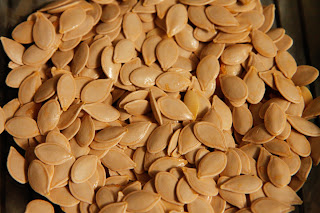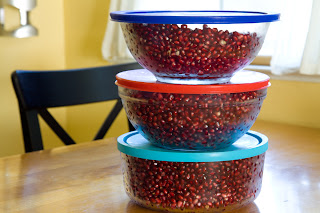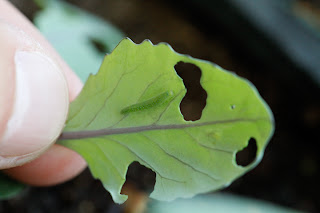On December 24th we harvested this beauty from the brassica bed along with some kale, sliced up a chorizo, and transformed it all into a traditional Portugese soup. Because it was a red cabbage, the Caldo Verde turned out more like a Caldo Verde y Rojo, but no matter.
 |
| Ruby ball cabbage |
Caldo Verde--"green broth" in Portugese--is often made with collard greens, but many people substitute kale. Potatoes are another main ingredient. The soup is commonly served at Portugese celebrations, and given that Mr. English has some Portugese roots, it was a fitting Christmas Eve meal for our family. We served it with roasted garlic and dry jack toasts, for a hearty and filling night-before-Christmas dinner. The next day it made a perfect Christmas Day lunch.
The chickens got a Christmas present as well this week. For reasons I can't understand, given that I haven't seen a live cabbage butterfly in the yard for at least two months, there are still loads of cabbage butterfly worms on my cabbage plants. Those eggs must have a long shelf life! Even with the near-freezing nighttime temperatures we've been having, these worms somehow survive tucked up against the ribs of the cabbage leaves.
 |
| Cabbage worm on a cabbage leaf in late December |
I collected a nice handful for the chickens, who are always eager to snap them up. The chickens have been confined to their run more than usual lately with all the downpours we've had, and they haven't had much foraging time, so I'm sure they really enjoyed the "verme verde".
 |
| Chicken snacks |
 |
| Yum! |
It's quiet in the garden this time of year. That's a good thing, not only because the rain makes me want to stay inside with a cuppa hot cocoa and a bowl of buttered popcorn, but also because I started working part-time in the classroom last month. I haven't had as much time to work in the yard (or write about it!) as I get a handle on my new responsibilities and get to know my students. By the time I'm really settled in next month, it will be perfect timing to think about starting seeds for next year's veggies.
In the meantime, kale and spinach are ready to harvest as needed, carrots and lettuce are growing slowly, garlic and onions are coming along, red clover is doing its job covering otherwise resting beds and providing greens for the chickens, and a bounty of shelling peas are in the forecast for spring. All that means I can take a worry-free break from the garden this week, enjoy time with family and friends, and make plans for the New Year.
Happy holidays, and I hope you're getting some rest this winter season, too!
















































